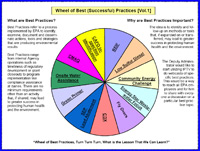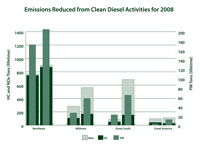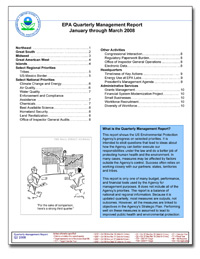"We are the first Agency ever to win this award back-to-back. It's one of many signs of EPA's commitment to accountability and excellence."

Marcus Peacock, Deputy Administrator of EPA, accepts the PQA Award for Overall Management from Hon. Michael W. Hager, Acting Director, U.S. Office of Personnel Management.
In 2008, for the second year in a row, EPA was awarded the President's Quality Award for Overall Management. As the first agency to win this award back to back, EPA has become a model for other federal agencies by operating with a results-oriented, data-driven, performance management approach. In 2008, EPA further integrated its management systems, embarked on new improvement strategies and approaches, set new goals, and accomplished great results.
Building and Instituting Success at the EPA: President's Quality Award 2008 Application (PDF) (32 pp, 8.38MB, About PDF)
Some of EPA's most significant accomplishments are:

EPA's mission cascades down to more specific goals and objectives, like a fountain.
- The first Federal Agency to create a 'stat' program;
- The only agency to have our senior career managers regularly meet to make decisions regarding improving our operations and management systems;
- The first Agency to internally broadcast live, regular senior management progress meetings;
- The first Agency to produce a quarterly management report designed for the public;
- The only Agency to create a new organization, the Program Analysis Division, whose full-time job is to look for ways to improve operations and outcomes;
- One of only a few Agencies to systematically capture, disseminate, and validate best practices;
- The second Agency to achieve, and keep, the highest possible score on the President's Management Agenda.
EPA's Integrated Management Systems
The President charged EPA to "accelerate the pace of environmental protection while maintaining our nation's economic competitiveness." This means cost effectively protecting and enhancing our air, water, and land resources. This means EPA needs an integrated system that frequently evaluates whether we are achieving our mission and whether there are better ways of getting results. That system is EPAStat. In 2008, EPA formally integrated its management systems under the single name EPAStat. An important part of this integration was creating a "clear line of sight" between day-to-day activities and eventual environmental outcomes. EPA also expanded the scope of our management systems to include external partners who help us achieve our mission, such as state environmental agencies, so that they are part of our integrated system and share our "clear line of sight." Taken together, the integration of these systems underpins our ability to learn, adopt, adapt and change.
Providing Critical Management Information

The Wheel of best practices (PDF) (1 pg, 37K, About PDF) highlights best practices from regions at Regional EPAStat meetings.
Achieving our mission is dependent on managers throughout the organization having access to appropriate tools, data, and information. In 2008, EPA implemented two important changes, unusual in the Federal government, that make us a leader in providing management information to everyone who needs it. First we launched 'participatory' management processes and, second, we consolidated performance measures in a single accessible data library called Measures Central. Each of these two major areas of change is discussed below.
Making Informed Decisions

The EPAStat report now includes a diesel emission reduction measure to better show the environmental impact of diesel projects
Since its inception, EPA has sought to be 'data-driven' in setting the nation's environmental and human health standards. Appropriate and timely data and analysis are critical to the Agency's efforts to "accelerate the pace of environmental protection while maintaining our nation''s economic competitiveness." Over the past few years, EPA has become just as committed to using performance data to inform management decisions, as it is to using sound science, economic and policy analysis in regulatory decisions.
A Culture of Performance Management
Until recently, performance measures and program analysis was limited primarily to the Agency's budgeting and planning community. The Government Performance and Results Act (GPRA) and OMB's Program Assessment and Reporting Tool (PART) provided some common language but there was a limited performance management culture within the Agency. Over the past few years, that has changed. Several factors have contributed to this change: a consistent, and fairly persistent, use of performance measurement in the Agency's strategic planning, indicator, and performance management arenas. In addition, the EPAStat program has made performance management principles, tools, uses and results commonplace.
EPA Gets Results
Molly O'Neill, Associate Administrator for EPA's Office of Environmental Information, describes the National Dialogue. *This video is not yet captioned. Captioning is forthcoming. Go to our contact us page for assistance.
EPA has steadfastly embraced an integrated performance management culture that delivers results. The creation of EPAStat provides the Agency a unifying and reinforcing philosophy that integrates management systems, makes information available to managers and staff in consistent and meaningful ways, informs decisions in a structured manner, and promotes understanding and common language around a culture of performance management. As a result of this commitment, EPA is delivering environmental results, incorporating the expertise, experience and perspectives of strategic partners into its "line of sight," and improving its operations. EPA is proud of its accomplishments and is gladly sharing its successful practices and lessons learned with the broader Federal government.
![United States Environmental Protection Agency [seal] US EPA](https://webarchive.library.unt.edu/eot2008/20090117165025im_/http://www.epa.gov/epafiles/images//logo_epaseal-aara.gif)
